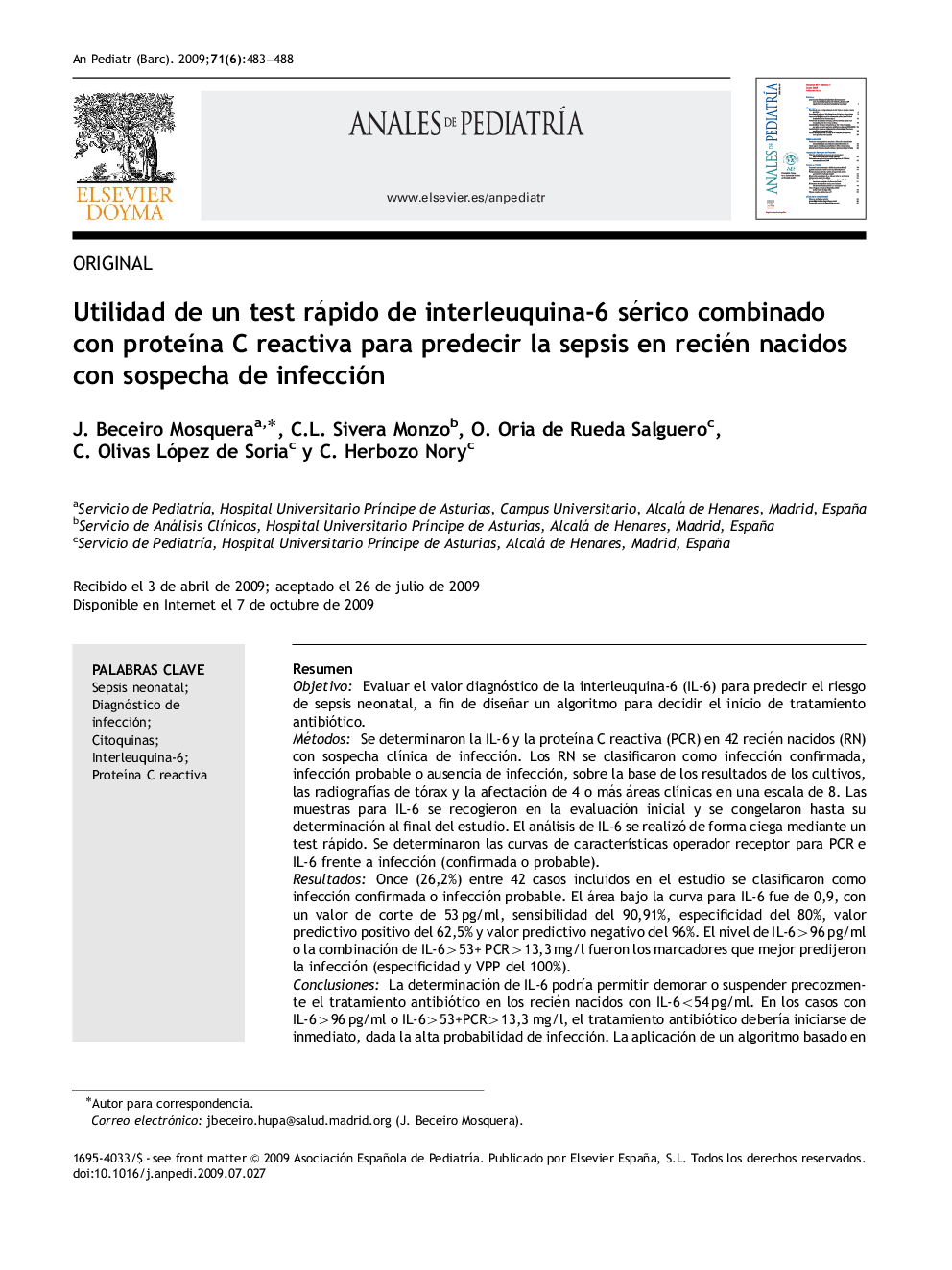| Article ID | Journal | Published Year | Pages | File Type |
|---|---|---|---|---|
| 4143493 | Anales de Pediatría | 2009 | 6 Pages |
ResumenObjetivoEvaluar el valor diagnóstico de la interleuquina-6 (IL-6) para predecir el riesgo de sepsis neonatal, a fin de diseñar un algoritmo para decidir el inicio de tratamiento antibiótico.MétodosSe determinaron la IL-6 y la proteína C reactiva (PCR) en 42 recién nacidos (RN) con sospecha clínica de infección. Los RN se clasificaron como infección confirmada, infección probable o ausencia de infección, sobre la base de los resultados de los cultivos, las radiografías de tórax y la afectación de 4 o más áreas clínicas en una escala de 8. Las muestras para IL-6 se recogieron en la evaluación inicial y se congelaron hasta su determinación al final del estudio. El análisis de IL-6 se realizó de forma ciega mediante un test rápido. Se determinaron las curvas de características operador receptor para PCR e IL-6 frente a infección (confirmada o probable).ResultadosOnce (26,2%) entre 42 casos incluidos en el estudio se clasificaron como infección confirmada o infección probable. El área bajo la curva para IL-6 fue de 0,9, con un valor de corte de 53 pg/ml, sensibilidad del 90,91%, especificidad del 80%, valor predictivo positivo del 62,5% y valor predictivo negativo del 96%. El nivel de IL-6>96 pg/ml o la combinación de IL-6>53+ PCR>13,3 mg/l fueron los marcadores que mejor predijeron la infección (especificidad y VPP del 100%).ConclusionesLa determinación de IL-6 podría permitir demorar o suspender precozmente el tratamiento antibiótico en los recién nacidos con IL-6<54 pg/ml. En los casos con IL-6>96 pg/ml o IL-6>53+PCR>13,3 mg/l, el tratamiento antibiótico debería iniciarse de inmediato, dada la alta probabilidad de infección. La aplicación de un algoritmo basado en la determinación de IL-6 y PCR, en la evaluación inicial de los RN con sospecha clínica de infección, podría reducir el consumo innecesario de antibióticos.
AimTo evaluate the diagnostic value of interleukin-6 (IL-6) to predict the likelihood of neonatal sepsis in order to design an algorithm to decide antibiotic therapy.MethodsIL-6 and C-reactive protein (CRP) were determined in 42 newborns with clinical suspicion of infection. Newborns were classified as a confirmed, probable or no infection, based on the results of cultures, chest X-rays and the involvement of four or more clinical areas on a scale of eight. Samples for IL-6 were collected in the initial assessment and frozen until its determination at the end of the study. Blinded IL-6 measurements were performed using a rapid test. Receiver operator characteristics curves (ROC) for CRP and IL-6 versus infection (confirmed or probable) were determined.ResultsAmong the 42 cases included in the study 11 (26.2%) were classified as confirmed or probable infection. The area under curve (AUC) for IL-6 was 0.9, with a cut-off value of 53 pg/ml: sensitivity 90.91%, specificity 80%, positive predictive value (PPV) 62.5% and negative (NPV) 96% The level of IL-6>96 pg/ml and/or the combination of IL-6>53+CRP>13.3 mg/l, were the markers that best predicted infection: specificity 100% and PPV: 100%.ConclusionsAssessment of IL-6 could allow withholding or early discontinuation of antibiotics in newborns with IL-6<54 pg/ml. In cases with IL-6>96 pg/ml and/or IL-6>53+ CRP>13.3, antibiotics should be started promptly, given the high likelihood of infection. Implementation of an algorithm based on the determination of IL-6 and CRP, in the initial assessment of the newborn with clinical suspicion of infection, could reduce unnecessary antibiotic therapy.
